
The Schutzstaffel was a major paramilitary organisation under Adolf Hitler and the Nazi Party in Nazi Germany, and later throughout German-occupied Europe during World War II.
The Sturmabteilung was the original paramilitary wing of the Nazi Party. It played a significant role in Adolf Hitler's rise to power in the 1920s and 1930s. Its primary purposes were providing protection for Nazi rallies and assemblies, disrupting the meetings of opposing parties, fighting against the paramilitary units of the opposing parties, especially the Roter Frontkämpferbund of the Communist Party of Germany (KPD) and the Reichsbanner Schwarz-Rot-Gold of the Social Democratic Party of Germany (SPD), and intimidating Romani, trade unionists, and especially Jews.

Der Stahlhelm, Bund der Frontsoldaten, commonly known as Der Stahlhelm, was a German First World War veteran's organisation existing from 1918 to 1935. In the late days of the Weimar Republic, it was closely affiliated to the monarchist German National People's Party (DNVP), placed at party gatherings in the position of armed security guards.

The uniforms and insignia of the Schutzstaffel (SS) served to distinguish its Nazi paramilitary ranks between 1925 and 1945 from the ranks of the Wehrmacht, the German state, and the Nazi Party.
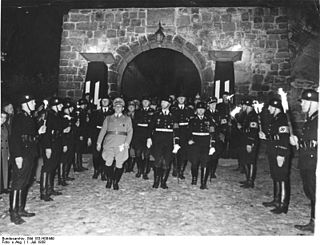
The Allgemeine SS was a major branch of the Schutzstaffel (SS) paramilitary forces of Nazi Germany; it was managed by the SS Main Office (SS-Hauptamt). The Allgemeine SS was officially established in the autumn of 1934 to distinguish its members from the SS-Verfügungstruppe, which later became the Waffen-SS, and the SS-Totenkopfverbände, which were in charge of the Nazi concentration camps and extermination camps. SS formations committed many war crimes against civilians and allied servicemen.

The Ordnungspolizei, abbreviated Orpo, meaning "Order Police", were the uniformed police force in Nazi Germany from 1936 to 1945. The Orpo organisation was absorbed into the Nazi monopoly on power after regional police jurisdiction was removed in favour of the central Nazi government. The Orpo was controlled nominally by the Interior Ministry, but its executive functions rested with the leadership of the SS until the end of World War II. Owing to their green uniforms, Orpo were also referred to as Grüne Polizei. The force was first established as a centralised organisation uniting the municipal, city, and rural uniformed police that had been organised on a state-by-state basis.

Kurt Max Franz Daluege was a German SS and police official who served as chief of Ordnungspolizei of Nazi Germany from 1936 to 1943, as well as the Deputy/Acting Protector of Bohemia and Moravia from 1942 to 1943.
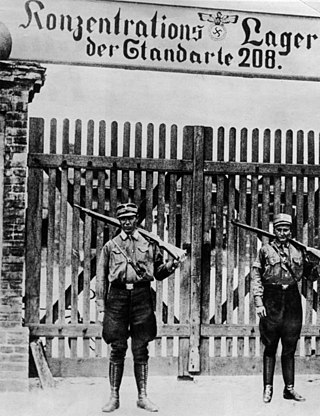
The uniforms and insignia of the Sturmabteilung (SA) were Nazi Party paramilitary ranks and uniforms used by SA stormtroopers from 1921 until the fall of Nazi Germany in 1945. The titles and phrases used by the SA were the basis for paramilitary titles used by several other Nazi paramilitary groups, among them the Schutzstaffel (SS). Early SS ranks were identical to the SA, since the SS was originally considered a sub-organisation of the Sturmabteilung.

Federal elections were held in Germany on 5 March 1933, after the Nazi seizure of power on 30 January 1933 and just six days after the Reichstag fire. The election saw Nazi stormtroopers unleash a widespread campaign of violence against the Communist Party (KPD), left-wingers, trade unionists, the Social Democratic Party, and the Centre Party. They were the last multi-party elections in a united Germany until 1990.
Polizei is the German word for police. Police in Germany, Austria and Switzerland consist of different agencies. It might refer to:
There were two main Police forces of Nazi Germany under the Reichsführer-SS, Heinrich Himmler from 1936:

Technische Nothilfe was a German organisation. It began as a strikebreaker organisation after the First and Second World Wars, but developed into a volunteer emergency response unit. During the Nazi period TN became in charge of technical civil defence.
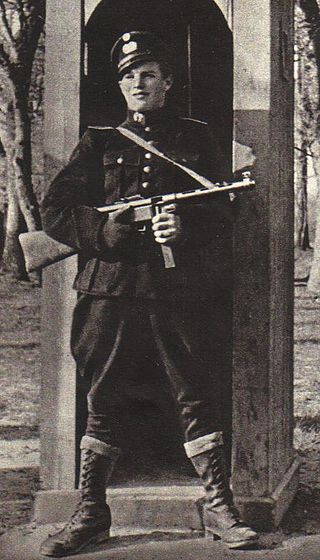
The HIPO Corps was a Danish auxiliary police corps, established by the German Gestapo on 19 September 1944, when the Danish civil police force was disbanded and most of its officers were arrested and deported to concentration camps in Germany. The majority of HIPO members were recruited from the ranks of Danish Nazi collaborators. The word HIPO is an abbreviation of the German word Hilfspolizei.
A field force in British and Indian Army military parlance is a combined arms land force operating under actual or assumed combat circumstances, usually for the length of a specific military campaign. It is used by other nations, but can have a different meaning.
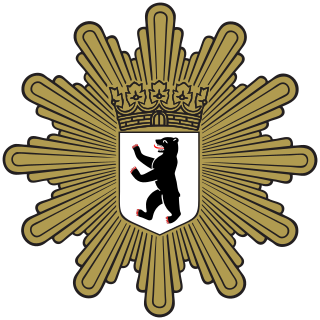
The Berlin Police is the Landespolizei force for the city-state of Berlin, Germany. Law enforcement in Germany is divided between federal and state (Land) agencies.

Adolf Hitler, the dictator of Nazi Germany, initiated World War II in Europe with the invasion of Poland in September 1939 and was central to the Holocaust. He was hated by his persecuted enemies and even by some of his own countrymen. Although attempts were made to assassinate him, none were successful. Hitler had numerous bodyguard units over the years which provided security.

August Edler von Meyszner was an Austrian Gendarmerie officer, right-wing politician, and senior Ordnungspolizei officer who held the post of Higher SS and Police Leader in the German-occupied territory of Serbia from January 1942 to March 1944, during World War II. He has been described as one of Reichsführer-SS Heinrich Himmler's most brutal subordinates.
Luftschutzpolizei (LSP)(Air Raid Protection Police) was the local civil defense organization in Nazi Germany.
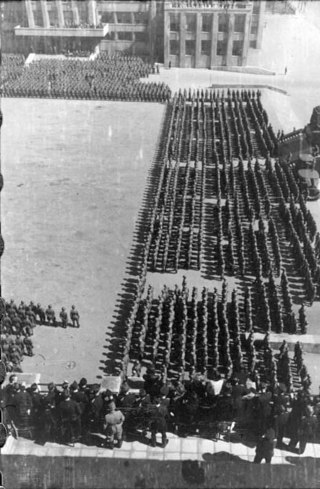
The Order Police battalions were militarised formations of the German Ordnungspolizei during the Nazi era. In World War II, they were subordinated to the SS and deployed in German-occupied areas, specifically the Army Group Rear Areas and territories under German civilian administration. Alongside detachments from the Einsatzgruppen and the Waffen-SS, these units perpetrated mass murder of the Jewish population and were responsible for large-scale crimes against humanity targeting civilian populations.
Johannes Rudolf Georg Hans Döring was a German Nazi Party politician, SS-Brigadeführer and officer in the Waffen-SS. He held important SS commands in several major cities of Nazi Germany and served as an SS and Police Leader in Stalino during the Second World War.















